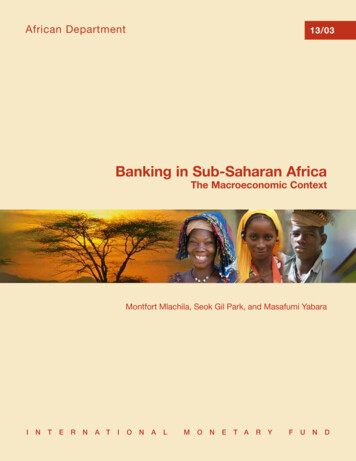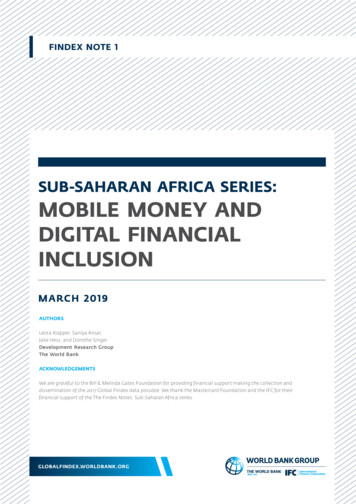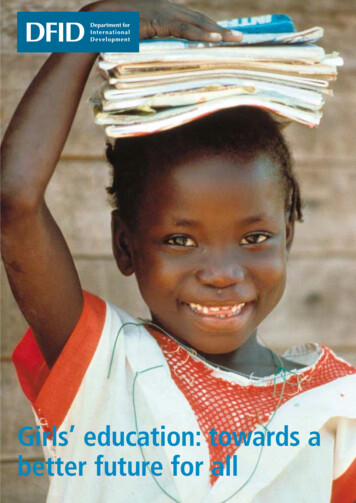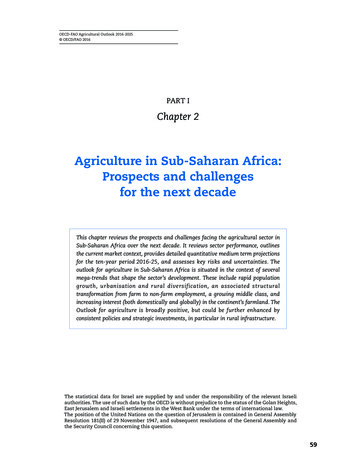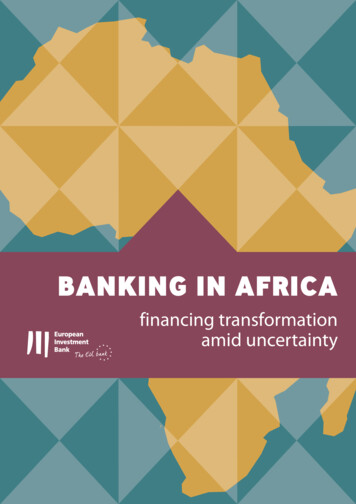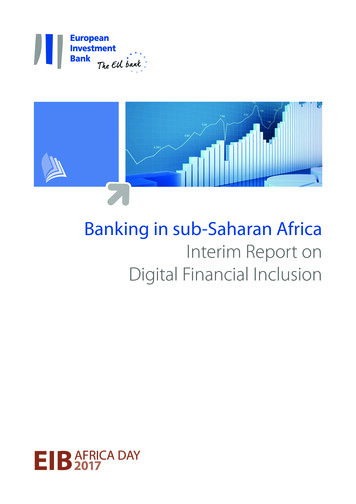
Transcription
Banking in sub-Saharan AfricaInterim Report onDigital Financial InclusionEIBAFRICA DAY2017
Banking in sub-Saharan Africa:Interim Report on Digital Financial InclusionNovember 2017
Banking in sub-Saharan Africa: Interim Report on Digital Financial InclusionAbout the ReportThis report summarizes the discussions held in the context of the Roundtable on Digital Financial Inclusion inAfrica during the 2017 EIB Africa Day, which was co-organized in Berlin on July 6th, 2017 by the EIB, AfrikaVerein der Deutschen Wirtschaft and the German Federal Ministry for Economic Cooperation andDevelopment. It aims at providing an interim thematic update in between two editions of the EIB’s Study ofBanking Sectors in sub-Saharan Africa.About the Economics Department of the EIBThe mission of the EIB Economics Department is to provide economic analyses and studies to support the Bankin its operations and in the definition of its positioning, strategy and policy. The Department, a team of 40economists, is headed by Debora Revoltella, Director of Economics.Contributors:This report was prepared by Jean-Philippe Stijns, Senior Economist, with research assistance from SofiiaBorysko, under the supervision of Barbara Marchitto, Head of Country and Strategy in the EconomicsDepartment of the European Investment Bank.The EIB Economics Department is grateful to the panellists for their input and feedback on earlier drafts of this paper.The EIB wishes to thank the following organisations for the use of photographs: Afrika-Verein Veranstaltung, M-BIRR. European Investment Bank, November 2017.Disclaimer:The views expressed in this publication are those of the authors, reflecting the contributions of roundtablepanellists, and do not necessarily reflect the position of the EIB.
Banking in sub-Saharan Africa: Interim Report on Digital Financial InclusionExecutive SummaryMobile and digital technologies have helped boost financial inclusion in sub-Saharan Africasignificantly in recent years. The percentage of adults with an account rose from 24% in 2011 to 34%in 2014.1 Mobile money services provided by FinTechs and Telcos are increasingly filling the gaps leftby traditional banks. 2 Mobile money services do not require the same investment in branchinfrastructure as traditional banks and agent banking serves low-population density areas at asignificantly lower cost than traditional banks. Digital finance still has untapped potential in SSA,provided financial services are tailored to local context and end-user characteristics.The EIB roundtable on Digital Financial inclusion in SSA addressed how to engage the bottom of thepyramid, including female entrepreneurs and MSMEs. There is a need to strike the right balancebetween leveraging opportunities and managing risks. Issues of trust, financial capability, regulation,compliance and inter-operability loom large. The role that FinTechs and banks can play in inclusivefinance crucially depends on the features of the market in which they operate. Reaching the bottomof the pyramid requires client-centred innovation and the design of products targeting minoritiesand vulnerable segments of society, including older and disabled people and recognising gender asan additional layer of inequality. Innovative uses of transactional and alternative data can caterdigitally to entrepreneurs, and new forms of collaboration between banks, supply chains andFinTechs will continue to emerge.Reaping the full benefits of digital financial inclusion in SSA requires a comprehensive and coherentmulti-stakeholder approach. Such an approach must include the development of a shared vision fordigital finance, in which partners play to their different strengths, with support from nationalgovernment and the aim of providing inter-operable, adaptive and scalable solutions. To build trustbetween the stakeholders, policy-makers need to articulate and clearly communicate policyobjectives and foster domestic and international collaboration, including in terms of peer learning.Consumer protection and supervision ought to keep pace with the rapid changes in the industry.Policy-makers should be pro-technology whilst remaining technologically neutral. This means thatregulators should encourage technological innovation with an eye to consumer protection andfinancial stability but refrain from using regulations as a means to push the market towards aparticular structure. Rather, they should leave it to market players to adopt whatever technology ismost appropriate, making sure that the same regulatory principles apply to all types of marketplayers.Platforms such as the G20’s GPFI have the potential to identify and share promising examples,strengthen networks, promote collaboration and peer-to-peer learning and pave the way forsuccessful implementation. IFIs/DFIs should take part in the global dialogue on digital financialinclusion and support the development of digital finance infrastructure.1For 2011, this figure covers accounts at a bank or other types of financial institution, and for 2014 it also covers mobileaccounts.2FinTech is used in this paper in its broadest definition as any new technology, software and innovation used to support orenable banking and financial services, typically via mobile phones, in sub-Saharan Africa. Telco is short hand for TelephoneCompany, a provider of telecommunications services, such as telephony and data communications. European Investment Bank, November 20171
2 European Investment Bank, November 2017
Banking in sub-Saharan Africa: Interim Report on Digital Financial InclusionIntroductionMarking the 2017 Africa Day co-hosted in Berlin on 6 July by the EIB, Afrika-Verein der deutschenWirtschaft and the German Federal Ministry for Economic Cooperation and Development, the EIBorganised a roundtable on Digital Financial Inclusion in Africa. Digital solutions have helped expandfinancial inclusion. A lot has been achieved in a relatively short time. However, much remains to bedone and the pace of digital financial inclusion has varied in different African countries. Against thisbackdrop, the panel addressed the key challenges and opportunities associated with digital financialinclusion from the perspective of consumers, SMEs, financial market players and policy-makers.The session was moderated by Barbara Marchitto, Head of Country and Financial Sector Analysis atthe EIB Economics Department. Six panellists took turns to deliver key messages from their differentperspectives and to answer questions from the floor. Volker Hey (Senior Policy Officer, BMZ)explained the role of the Global Partnership for Financial Inclusion (GPFI) and the G20 on the eve ofthe 2017 G20 Hamburg meeting. David Ashiagbor (Coordinator, Making Finance Work for Africa)highlighted the broad trends, opportunities and challenges regarding digital financial inclusion insub-Saharan African countries. Thierry Artaud, (Executive Chairman, M-BIRR), shared his company’sexperience of promoting digital financial inclusion in Ethiopia. Louise Holden (Head of Public PrivatePartnerships, MasterCard) discussed the role of public-private partnerships in promoting digitalfinancial inclusion in sub-Saharan Africa (SSA). Kennedy Komba (Head of Strategy and MemberRelations, Alliance for Financial Inclusion –AFI) laid out policy options to make financial servicesmore accessible to the world’s unbanked and to empower policy makers to increase access toquality financial services for the poorest populations. He also discussed trade-offs betweenstimulating innovation, providing an enabling environment and consumer protection, and made thecase for the importance of institutional capacity-building. Minerva Kotei (Financial Sector Specialist,SME Finance Forum) focused on how digitalization can help to expand access to finance for smalland medium-sized businesses, including women entrepreneurs. European Investment Bank, November 20173
Taking Stock of Financial Inclusion in SSADavid Ashiagbor (MFW4A) set the scene for the discussions by indicating that out of 590 millionadults in SSA, 350 million do not have access to an account at a bank or with another type offinancial institution. According to Global Findex data, financial exclusion affects a particularly highproportion of women, young people and people living in rural areas. For traditional banks, buildingbrick-and-mortar branches in low-population density areas is typically not economically viable. Eventhose who do have a current account often lack access to other basic financial services, includingsavings accounts, loans and insurance products. With only 34% of adults formally banked, there ishuge potential for the development of financial services in Africa to meet the needs of theunbanked.Figure 1: Account Ownership in SSASource: Global Financial Inclusion Database (FINDEX) data.The gap is increasingly filled by FinTechs and Telcos, mainly through mobile money services. Theyprovide a solution to the lack of infrastructure – via mobile banking – and in terms of last mileservices, via agent banking. The spread of mobile and digital technologies has already helped tosignificantly boost account ownership in SSA. The proportion of adults with an account, eithertraditional or mobile, rose from 24% in 2011 to 34% in 2014. Over the same period, the share ofadults with an account at a bank or a financial institution increased from 24% to 29%. Therefore,about half of the improvement in financial inclusion is due to the expansion of the traditionalbanking sector, the other half to that of mobile accounts (Figure 1). This trend is accelerating and byDecember 2016, there were 277 million registered mobile money accounts in SSA – more than thetotal number of bank accounts in the region. 3 More than 40% of the adult population in a number ofcountries, including Kenya, Tanzania, Zimbabwe, Ghana, Uganda, Gabon and Namibia, use mobilemoney on an active basis. 4344GSMA State of the Industry Report – Decade EditionAn active account is defined as an account that has had a transaction in the last 90 days. European Investment Bank, November 2017
Banking in sub-Saharan Africa: Interim Report on Digital Financial InclusionSSA is the leading region in terms of digital financial inclusion on several accounts. In 2014, 12% ofAfricans had a mobile money account, compared to a global figure of 2%. Around half of the world’smobile money providers operate in SSA. Of the 35 mobile money markets of the world that havereached 1 million active accounts, more than half are in SSA. The region is not only leading innumbers, but also in innovation and knowledge-sharing. For instance, Kenya is sharing its learningwith regulators and commercial banks from Latin America through the Alliance for FinancialInclusion (AFI) platform. As regards SSA, the concept of agent banking illustrates how FinTechs andtraditional banks are competing and/or collaborating. The term ‘agent banking’ refers to a situationwhere a financial service provider engages third parties – including shops, service stations and postoffices – to deliver financial services on their behalf. In practice, when the end-user is severalkilometres away from the nearest bank branch, being able to conduct a financial transaction in ashop is extremely convenient. Mobile accounts are evolving constantly and end-users can not onlytransfer money but they can also obtain a loan, pay it back, save etc. As such services keep onevolving, mobile account users may never go back to or adopt traditional banking services. In somecases, it is a traditional bank that is the ultimate principal behind mobile accounts provided andserviced by agents. In other cases, Telcos or FinTechs lead the way and offer digital financial serviceseither directly or via their own network of agents.There is, however, a striking diversity of situations with respect to financial inclusion throughoutSSA. The degree and nature of financial inclusion challenges vary significantly from country tocountry and call for tailored financial inclusion strategies. The case of Mauritius is ratherexceptional (Figure 2 below). There, the under-development of mobile accounts can be attributed tovery extensive reach through bank accounts, both in urban and rural areas. In Kenya and Botswanabank coverage is relatively good but not in rural areas where mobile accounts offer significantpotential. Other countries like Tanzania and Côte d’Ivoire are compensating their rural bank accountgap with rising mobile account coverage. In contrast, in countries like the DRC, Ghana, Gabon andNigeria the rural bank account gap still represents a largely untapped opportunity in terms of digitalfinancial inclusion. In Ethiopia, the deployment of mobile accounts is an even lower hanging fruit.Efforts to enhance digital financial inclusion in Ethiopia are discussed in detail in a later section onpp. 8-9. Correspondingly, there is a wide variety of country circumstances in terms of both mobilephone penetration and volume of mobile transactions (Figure 3 below). Most countries have seen arise on both accounts but mobile phone subscriptions do not necessarily translate into mobilemoney transactions. In fact, the highest shares of mobile transactions in GDP are observed incountries like Kenya, Tanzania and Uganda, which do not stand out particularly in terms of mobilephone penetration. Conversely, in countries like Botswana and Namibia where less than two thirdsof adults have a bank account, there are already more mobile phone subscriptions than inhabitantsand yet the volume of mobile money transactions is strikingly low. Mobile infrastructure is not themain bottleneck everywhere and digital financial inclusion has a high unrealised potential in manycountries. European Investment Bank, November 20175
Figure 2: Bank Account vs. Mobile Account Ownership in select SSA countries (2014)Source: Global Financial Inclusion Database (FINDEX) data.Figure 3: Value of Mobile Money Transactions vs. Mobile Phone Subscriptions in select SSAcountriesSource: Financial Access Survey (FAS), IMF; International Telecommunication Union (TBC).6 European Investment Bank, November 2017
Banking in sub-Saharan Africa: Interim Report on Digital Financial InclusionDigital Financial Inclusion of SMEs and Female EntrepreneursMinerva Kotei (SME Finance Forum) remarked that the SME financing gap continues to be astructural feature of developing economies. Even in countries that have policy measures to supportSMEs, the problem still prevails. According to IFC, there are about 400 million SMEs that haveunmatched credit needs. About half of these are from developing markets, representing 175220 million SMEs in developing countries with unmatched credit needs of USD 2.1-2.6 trillion. Ofthese, it is estimated that 81 million SMEs are based in SSA, with an outstanding credit gap ofUSD 132 billion. This gap represents a major credit opportunity for FinTechs, non-bank SME lendersand banks to explore. McKinsey estimates that SME banking revenues in developing markets globallytotalled USD 377 billion in 2015 (Manyika, Lund, Singer, White and Berry, 2016). A profitable SMEbanking model that tackles key SME-financing challenges simultaneously is needed for banks tobenefit from this opportunity. The key risk of SMEs, credit risk, is well known. In addition, SMEs areexpensive for banks to serve, especially given the small average size of transactions andcorresponding revenue per account, generating opportunities for digitization. Transactional andalternative data can help to address the SME financing conundrum (GPFI, SME Finance Forum,Germany 2017, World Bank, 2017).Many non-bank SME lenders are leapfrogging commercial banks by providing funding to SMEsutilising alternative data. However, there have also been collaborations between SME lenders andbanks. Both sides recognise that they have limits individually but that if they come together,opportunities arise. Digital SME lenders also partner amongst themselves, with other alternativelenders from the non-bank financial sector, and with cloud-based providers.There are four institutional models that rely on alternative data streams for SME lending. The firstare SME marketplace lenders. These non-bank digital lenders originate SMEs loans via platformsconnecting SME borrowers to their own balance sheet or to third party investors. Their use ofalternative SME data allows them to increase the pool of eligible SMEs and to simplify, speed up andlower the cost of SME credit. The second model is provided by global digital corporates who leveragetheir proprietary big data to offer SME finance. The third is mobile database lending platforms (e.g.Saficom, CBA’s M-Shwari, Sanctuary, KCB’s M-PESA, and Zuna in Zambia), which use mobile andmobile e-money services transaction history to score the creditworthiness of first-time borrowers.The fourth model is supply-chain finance platforms, which are becoming increasingly common inSSA. GoFinance in Tanzania, for instance, analyses the supply-chain structure as well as sales anddelivery data within a given supply chain to provide financial solutions for SMEs. They can lend asmuch as USD 30k to SMEs, utilising alternative data to manage risk. Existing bank players have alsolaunched their own database platforms, including Kenya’s Equity Bank and Airtel’s Equitel.Of the 81 million SMEs in SSA with a financing gap, 12 million have one or more femaleentrepreneurs. Women-owned SMEs encounter the many challenges SMEs face to an even greaterdegree. It is therefore important to focus on female-owned businesses and entrepreneurs to avoid’losing’ them in the system, with the attendant opportunity costs for the economy. For womenentrepreneurs, a world research ecosystem is needed to address the barriers that women face inaccessing financial services. There is a need to go beyond solely reaching existing womenentrepreneurs to actually make it easier for more women to become entrepreneurs by breakingdown some of the barriers that they face. The SME Finance Forum is working with its FinTech European Investment Bank, November 20177
members to see how they can partner with banks to apply technological innovation to boostfinancial access for women entrepreneurs.Once again, the key is to balance equity and innovation and to ensure that there is a competitivemarket where SMEs can thrive and banks can add value to SMEs. The good news is that marketplayers have really stepped up to capture opportunities available to cater to SMEs and that themarket is growing very fast. They are able to circumvent problems using machine learning and digitaldata to manage risk, and they are able to provide financial services very quickly and effectively.Increasingly innovative uses of transactional and alternative data to cater digitally to nativeentrepreneurs are to be expected. New forms of collaboration between banks, supply chains andFinTechs will continue to emerge.8 European Investment Bank, November 2017
Banking in sub-Saharan Africa: Interim Report on Digital Financial InclusionDigital Financial Inclusion: Opportunities and ChallengesOne key achievement of the G20’s GPFI has been to establish a consensus that digital financialinclusion is desirable and a priority because it can boost productivity and growth, improvetransparency, increase tax revenues and enhance the efficiency of public expenditure andtransfers (Better Than Cash Alliance, 2016). The four High-Level Principles for Digital FinancialInclusion are: (1) promoting a digital approach to financial inclusion, (2) balancing risk andinnovation to achieve financial inclusion, (3) creating an enabling legal and regulatory framework,and (4) expanding the digital financial services infrastructure ecosystem (GPFI, 2016).Volker Hey (BMZ) underscored that financial inclusion empowers individuals and businesses tofully tap their potential and goes far beyond simply providing better access to financial services forindividuals and SMEs. Increasing access to adequate financial services enables people to bettermanage their economic lives and gives people the freedom and capability to make their owndecisions so as to shape their own lives. Financial inclusion contributes to tackling inequality in anera when in-country social and economic inequalities are on the rise in many countries. It can help toreduce poverty at a time when 10% of the world’s population still lives on less than USD 2/day andlivelihoods are increasingly endangered by climate-related risks like floods or drought.For digital financial solutions to open up new opportunities, products have to be designed with theend-user in mind. The arrival of new actors – including Telcos and FinTechs – and changing businessmodels (based on big data, agents instead of bank branches etc.) brings new challenges and risks,both from a private sector and policy-maker’s perspective. Originally, FinTechs were expected todisrupt or even supplant traditional banking models. Incumbent financial institutions are indeedunder enormous pressure to cut the cost of their services (World Economic Forum, 2017). However,collaboration between banks and FinTechs is becoming the norm rather than the exception asFinTechs leverage banks to achieve scale and banks acquire FinTechs to obtain innovativetechnology at between a third and a quarter of the cost of in-house development (Kelly, Ferenzy andMcGrath, 2017).From a regulatory and supervisory perspective, a first set of challenges concerns trust andconsumer confidence. Striking the right balance between leveraging opportunities andsafeguarding against risks is critical to reaping the benefits of digital finance. Unfortunately,regulatory and supervisory capacity has generally not kept pace with changing market dynamics.Trust in digital financial services is under threat by a number of challenges including agent fraud,system failure, weak data security and privacy, and questionable safety of customer funds,particularly where non-bank players are involved. Technological advances carry with them significantcompliance issues, including Know Your Customer and AML-CFT procedures, especially in countrieswith ineffective identification. These advances also create challenges in terms of maintaining a levelplaying field for service providers.Consumer data protection, privacy and insolvency risks need to be addressed, especially given thevulnerability of customers and the common lack of financial education and awareness. Consumersneed to gain trust as this is new technology for most of them and they need to understand what willhappen to their funds in the event of insolvency. For instance, in the case of a non-bank financialintermediary with funds sitting in a trust account, what happens with the funds in case the Telcoruns into insolvency issues? Further, the integration of Telcos and non-banks in the financial system European Investment Bank, November 20179
raises the question of the ownership of the data created by mobile banking. Where regulation ofmarket conduct is ineffective, digital financial service agents may abuse the process or have anegative customer relationship. This can have negative effects on the ecosystem and on futureadoption of similar services or products.Supervising the agent-principal relationship is also a challenge, considering the importance ofmarket behaviour and consumer protection. Generally, in the agent-principal relationship,monitoring and penalties are supposed to be provided by the principal. As agents are managed bythe principal, the latter should therefore be liable in the event of any misconduct committed by theagent. However, the wider the network of agents, the more challenging the monitoring of agentbehaviour becomes and the higher the odds of abusive practice affecting end-users. In response,regulators and supervisors have innovated and started sampling agents, penalising those that getcaught, and creating reporting mechanisms through which consumers can lodge a complaint. Thereare good examples of Memoranda of Understanding (MoU) between the Central Bank, whichregulates financial intermediaries, and MNO regulators, which regulate the digital side of theproduct. In most SSA countries, the court system may not provide an efficient mechanism to resolvecommercial or consumer-related disputes. Alternative dispute resolution mechanisms codified in theregulation can offer solutions to these inefficiencies.The second set of challenges has to do with inclusion. Distribution outlets can be insufficientlyaccessible and acceptance by target populations low. Banks have been slow to engage with Telcosto develop more inclusive services and products. A third of all mobile money accounts are inactive,meaning that they have not seen any transactions for 3 months. This raises the question as towhether inclusion should be defined as having a point-of-access or, rather, services that customersactually use, be they savings, credit or insurance services. Trust in digital financial services can beenhanced by paying attention to financial risks and the take-up of digital financial services at thebottom of the pyramid, boosted by ensuring that regulation safeguards the interests and rights ofthe poorest end-users. Biometrics can address many of the issues associated with the lack orunreliability of identity mechanisms while digital footprints can be used as a source of creditreferencing. As a corollary, regulators need to ensure that digital identities are not abused.Regulatory supervision for data management, i.e. the collection, storage and protection of data,must be provided. The issues of identity protection and cybersecurity are critical.Kennedy Komba (AFI) emphasised the importance of clearly articulating the policy objectives, ofpromoting proportionality and a risk-based approach to regulation, and of data in decisionmaking, product design and policy reforms. Some countries have articulated their policy objectiveswithin the law itself, giving the Ministry of Finance or the Central Bank the remit for working onfinancial inclusion. Indeed, financial inclusion is increasingly becoming part of the mandate ofCentral Banks. Transparency is important: the public needs to be able to know what the Central Bankis doing for financial inclusion. This ensures certainty and consistency, a prerequisite for privatesector confidence and investment.Central banks are mandated to promote and protect financial stability, but they need to balancethis mandate with the need to foster financial inclusion. An enabling environment needs to beproportional and risk-based so that the cost of compliance is not excessive. Regulation needs to beflexible and broad-based. A very detailed regulation will soon be overtaken by market changes andthus require frequent reviews and amendments that involve a lengthy legislature process. New10 European Investment Bank, November 2017
Banking in sub-Saharan Africa: Interim Report on Digital Financial Inclusionunderwriting models may impact credit quality and macroeconomic variables as well, including newrisk management practices. Against this background, it is crucial to foster collaboration at theinternational level, including in terms of peer learning about what works best to build trust amongstprivate actors and amongst regulators who may not want to allow certain products on theassumption that inherent risks may affect financial stability.A third set of challenges has to do with interoperability, and how to connect the various marketplayers to allow for seamless transactions. The key is to consider the value proposition for both theprivate and the public sectors, including in terms of interoperability. When a regulatory frameworkdoes not take into consideration the different value propositions, conflicts can arise within themarket about whether the service should be offered through a bank-led model or a non-bank model.In some markets, there is competition between several players while in others there is a singledominant player. In some countries, the lion’s share of growth in financial transactions has taken theform of Over-the-Counter (OTC) activity, where a mobile money agent performs transactions onbehalf of customers.As a country’s mobile money market develops, attention should shift from facilitating investmentsto ensuring appropriate competition, aligning competition between banks and non-banks toenhance financial inclusion and making the regulatory frameworks of both sectors compatible. In aworld of connected products, systems and people, it is necessary to make connected solutions forfinancial inclusion. FinTechs encompass a wide array of business processes, including payments,investments, lending, insurance, wealth management, digital currency and big-data analysis in theform of B2C, B2B, C2C that may complement, overlap, compete, or disrupt banking operations.Indeed, banks are concerned that non-banking institutions have an advantage over them while somenon-banks are currently complaining that banks are presenting obstacles for them to interact withclients through banking operations. Therefore, regulators should be pro-technology but remaintechnologically neutral. Technology neutrality means that regulation designed to ensure consumerprotection and financial stability should describe the result to be achieved, but should allow marketplayers to adopt whatever technology is most appropriate to achieve the result. The same regulatoryprinciples should apply to all types of market player and regulators should refrain from usingregulations as a means to push the market towards a particular structure. Some financial inclusionproducts may look cost-effective at a low scale and yet lock domestic end-users into out-of-date andlocalised payment systems, preventing them from benefiting from innovation. European Investment Bank, November 201711
12 European Investme
Africans had a mobile money account, compared to a global figure of 2%. Around half of the world’s mobile money providers operate in SSA. Of the 35 mobile money markets of the world that have reached 1 million active accounts, more than half are in SSA. The region is not only leading
